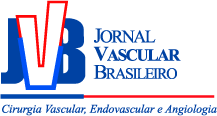Pesquisa de marcadores de trombofilia em eventos trombóticos arteriais e venosos: registro de 6 anos de investigação
Marcos Arêas Marques; Paulo Roberto Mattos da Silveira; Arno von Ristow; Marcus Gress; Alberto Vescovi; Bernardo Massière; José Mussa Cury Filho
Resumo
Palavras-chave
References
Egeberg O. Inherited antithrombin deficiency causing thrombophilia. Thromb Diath Haemorrh.. 1965;13:516-30.
Kottke-Marchant K , Duncan A. Antithrombin deficiency: issues in laboratory diagnosis. Arch Pathol Lab Med.. 2002;126:1326-36.
Kottke-Marchant K, Comp P. Laboratory issues in diagnosing abnormalities of protein C, thrombomodulin and endothelial cell protein C receptor. Arch Pathol Lab Med.. 2002;126:1337-48.
Goodwin AJ, Rosendaal FR, Kottke-Marchant K, Bovill EG. A review of the technical, diagnostic, and epidemiologic considerations for protein S assays. Arch Pathol Lab Med.. 2002;126:1349-66.
Bick RL, Kaplan H. Syndromes of thrombosis and hypercoagulability: Congenital and acquired causes of thrombosis. Med Clin North Am.. 1998;82:409-58.
Press RD, Bauer KA, Kujovich JL, Heit JA. Clinical utility of factor V Leiden (R506Q) testing for the diagnosis and management of thromboembolic disorders. Arch Pathol Lab Med.. 2002;126:1304-18.
McGlennen RC, Key NS. Clinical and laboratory management of the prothrombin G20210A mutation. Arch Pathol Lab Med.. 2002;126:1319-25.
Zivelin A, Mor-Cohen R, Kovalsky V. Prothrombin 20210GA is an ancestral prothrombotic mutation that occured in whites approximately 24.000 years ago. Blood.. 2006;107:4666-8.
Ho WK, Hankey GJ, Quinlan DJ, Eikelboom JW. Risk of recurrent venous thromboembolism in patients with common thrombophilia: a systematic review. Arch Intern Med.. 2006;166:729-36.
Lonn E, Yusuf S, Arnold MJ. Homocysteine lowering with folic acid and B vitamins in vascular disease. N Engl J Med.. 2006;354:1567-77.
Cattaneo M. Hyperhomocysteinemia and venous thromboembolism. Semin Thromb Hemost.. 2006;32:716-23.
Levine JS, Branch W, Rauch J. The antiphospholipid syndrome. N Engl J Med.. 2002;346:752-63.
Thrombophilia and venous thromboembolism: International consensus statement. Guidelines according to scientific evidence. Int Angiol.. 2005;24:1-26.
Miyakis S, Lockshin MD, Atsumi T. International consensus statement on an update of the classification criteria for definite antiphospholipid syndrome (APS). J Thromb Haemost.. 2006;4:295-306.
Franco RF. Trombofilias hereditárias. Doenças vasculares periféricas. 2002.
Bick RL, Kaplan H. Síndromes de trombose e hipercoagulabilidade. Trombose. 1998.
Petri M. Epidemiology of the antiphospholipid antibody syndrome. J Autoimmun.. 2000;15:145-51.
Bick RL. Hereditary and acquired thrombophilic disorders. Clin Appl Thromb Hemost.. 2006;12:125-35.
Van Cott EM, Laposata M, Prins MH. Laboratory evaluation of hypercoagulability with venous or arterial thrombosis: venous thromboembolism, myocardial infarction, stroke, and other conditions. Arch Pathol Lab Med.. 2002;126:1281-95.
Bick RL. Antiphospholipid thrombosis syndromes: etiology, pathophysiology, diagnosis and management. Int J Hematol.. 1997;65:193-213.
Paschôa AF. Impacto da pesquisa laboratorial de trombofilia na prevenção secundária e orientação dos doentes com tromboembolismo venoso. J Vasc Bras.. 2006;5:331-2.
Simioni P. Who should be tested for thrombophilia?. Curr Opin Hematol.. 2006;13:337-43.

